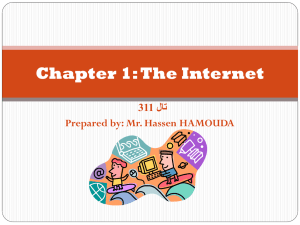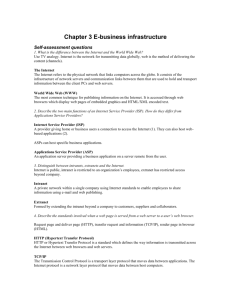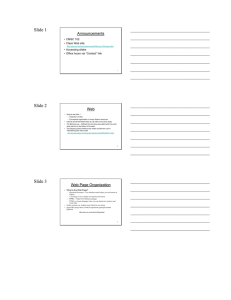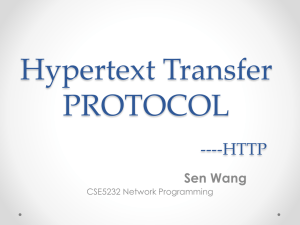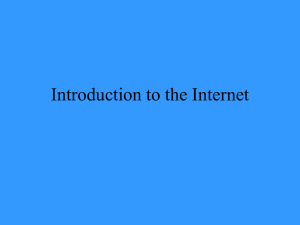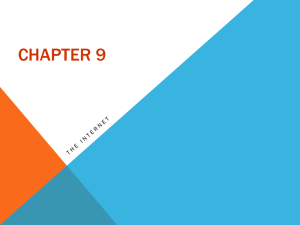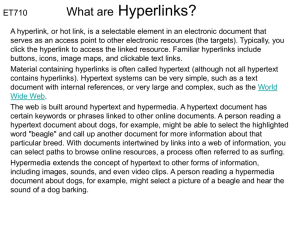this lecture as PDF here
advertisement
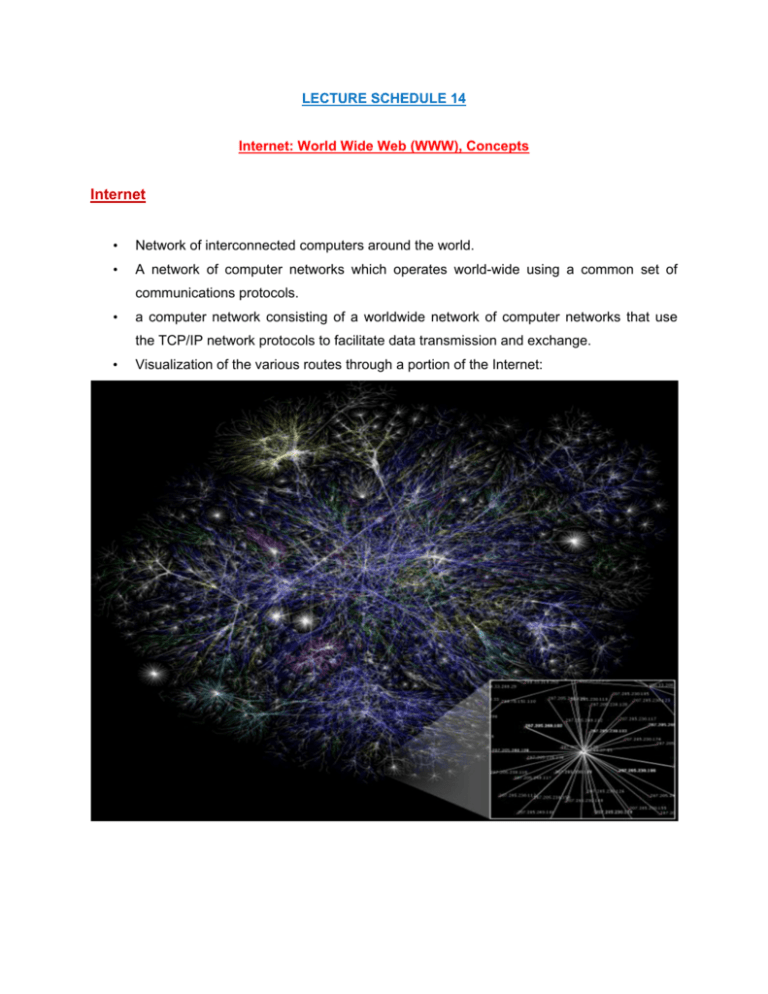
LECTURE SCHEDULE 14 Internet: World Wide Web (WWW), Concepts Internet • Network of interconnected computers around the world. • A network of computer networks which operates world-wide using a common set of communications protocols. • a computer network consisting of a worldwide network of computer networks that use the TCP/IP network protocols to facilitate data transmission and exchange. • Visualization of the various routes through a portion of the Internet: What do we need to get connected to internet? • Getting on the Internet requires: – Computer – Modem – Telephone Line – Internet Service Provider (ISP) – Communication Software Modem and Telephone Line • • Modem is a communications device • Telephone services, such as that allows us to communicate with – ISDN, another computer through telephone – 56K leased lines, and lines. – T-1 connections Modem is abbreviation of modulator/demodulator. • offer connections to the Internet at considerably faster connection speeds. Internet Service Provider (ISP) • An Internet Service Provider (ISP) is a company that allow you to use their internet connection for a price. • When you register with an ISP the followings are given: – Username • – A unique name that identifies you. Password • A secret code that prevents other people from using your account. Some Popular Internet Service Providers • AT&T WorldNet • Microsoft Network • America Online • In India: – VSNL (Videsh Sanchar Nigam Limited – MTNL (Mahanagar Telecom Nigam Limited) – BSNL (Bharat Sanchar Nigam Limited) – Satyam Onlile Communication Software • Computer needs communicate • on software to allow you to get connected to, and interact with, the Internet. • Communication software is of two types: – Software that Helps Establish Basic Internet Connectivity – Software that helps to browse, access e-mail etc. World Wide Web "The World Wide Web is the universe of network-accessible information, an embodiment of human knowledge." • Tim Berners-Lee, a scientist at CERN (The European Organization for Nuclear Research (French: Organisation Européenne pour la Recherche Nucléaire), invented the World Wide Web (WWW) in 1989. • The Web was originally conceived and developed to meet the demand for automatic information sharing between scientists working in different universities and institutes all over the world. • The basic idea of the WWW was to merge the technologies of personal computers, computer networking and hypertext into a powerful and easy to use global information system. • The World Wide Web, abbreviated as WWW and commonly known as The Web, is a system of interlinked hypertext documents contained on the Internet. • With a web browser, one can view web pages that may contain text, images, videos, and other multimedia and navigate between them by using hyperlinks. Hypertext • Hypertext is text displayed on a computer or other electronic device with references (hyperlinks) to other text that the reader can immediately access, usually by a mouse click or keypress sequence. • Apart from running text, hypertext may contain tables, images and other presentational devices. Hypertext is the underlying concept defining the structure of the World Wide Web, making it an easy-to-use and flexible format to share information over the Internet. Web Browser • A web browser is a software application for retrieving, presenting, and traversing information resources on the World Wide Web. An information resource is identified by a Uniform Resource Locator (URL) and may be a web page, image, video, or other piece of content. • Example of Web Browser: o Mosaic o Internet Explorer o Netscape Navigator o Mozilla Firefox Web Page and Websites • W3 contains several millions of pages of information. Each of these pages is called a Web Page. • A webpage or web page is a document or resource of information that is suitable for the World Wide Web and can be accessed through a web browser and displayed on a computer screen. • A web page can contain text, pictures, sound, animation and video. • A group of related web pages that are linked together form a Web Site. • The first page of a web site is called the Home Page. • The Home Page shown below is the Home Page of the official website of Tail Nadu Agriculture University. Universal Resource Locator • Each web page has a unique address called Universal Resource Locator (URL). • Contains unique information about the server and the path on the server to find and retrieve the information Example: http://www.usd.edu/trio/tut/start/url.html http:// protocol – rules through which transmission takes place over the internet. www.usd.edu/ server name - computer domain name trio/tut/start/ pathname to the directory you are requesting url.html filename you are requesting Search Engine • A web search engine is designed to search for information on the World Wide Web. The search results are usually presented in a list of results and are commonly called hits. • Few examples of web search engines are: Google.com Ask.com Yahoo.com Bing.com TripleMe.com Shopzilla.com




